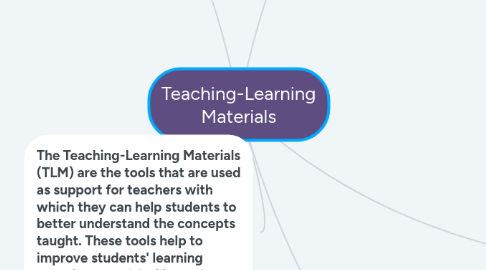
1. Textbooks are prescribed for all subjects, these include, science, social science, Hindi, English, mathematics, and so on.
2. The Teaching-Learning Materials (TLM) are the tools that are used as support for teachers with which they can help students to better understand the concepts taught. These tools help to improve students' learning experience and facilitate the retention of information as long as it is used properly.
3. There are several types of Teaching-learning materials, and those are classified into many types.
3.1. Audio and Video TLMs
3.1.1. Audio and video TLMs include audio discs, tapes, drawing charts, posters, maps, models, mock-up, diorama, globe, relief maps.
3.2. Textbooks
3.3. Maps
3.3.1. Maps are regarded as useful tools in every discipline
3.4. Charts
3.4.1. It is a visual representation that is used to summarise, illustrate, compare and contrast and communicate the subject matter in a coherent manner.
3.5. Posters
3.5.1. Posters are meant to provide information among the learners regarding an important concept.
3.6. Models
3.6.1. Usually a model is similar to the original object in every aspect except the size. The size of an object may be reduced or enlarged. For example, globe is the model of the earth.
3.7. Overhead Projector
3.7.1. It is a simple projector, which is manageable to operate and is widely used by educators within schools, colleges and universities.
3.8. Power Point Slides
3.8.1. These can be used for small and large audiences.
3.9. Computers
3.9.1. Computers are significance in acquiring an efficient understanding of academic concepts.
3.10. Other Reading Materials
3.10.1. These are referred to articles, documents, reports, assignments, projects, newspapers, magazines and books that are used to augment understanding of concepts.
4. There are 3 points that must be taken into account when preparing teaching-learning materials.
4.1. collection
4.1.1. It is referred to collection of materials
4.2. preparation
4.2.1. After collecting the necessary materials, the preparation is carried out, which is nothing more than the organization, design and development of the materials, for this, the grade levels, learning abilities and academic goals of the students must be taken into account.
4.3. maintenance
4.3.1. It is the activity through which the required care is provided to TLMs, this favors sustainability and availability for future uses. To provide proper maintenance we must take into account these aspects: the proper space should be made available for storing them, these should be neatly arranged, they should be checked from time to time and repairs need to get carried out, when required.
5. Developing creativity.
6. the importance of teaching-learning materials is focused on 5 aspects.
6.1. Student motivation.
6.2. Evoking prior knowledge.
6.3. Encouraging the processes of interpreting, understanding, organizing and amalgamating the educational content, logical thinking, reasoning, and communication.
6.4. contributing to the development of different skills, values and attitudes among studens.
7. The main objective of teaching-learning materials is to promote in students the desire to learn. these are the principal objectives.
7.1. Motivate Learners.
7.1.1. Ensures that students are able to develop interest and enthusiasm towards learning.
7.2. Development of Knowledge and Skills among Teachers.
7.2.1. By performing their duties effectively, teachers show their ability to help students.
7.3. Help in Longer Retention of Information
7.3.1. Teachers should try to capture the full attention of students so that they can effectively retain longer the new information.
7.4. Facilitate Holistic Learning
7.4.1. Students acquire learning that covers not only class topics but the knowledge acquired helps them develop their psycho-motor, cognitive and intellectual skills.
7.5. Help in Organizing Classroom Teaching
7.5.1. helps teachers organize their work plan and effectively implement work methods.
7.6. Promoting Effective Communication
7.6.1. It promotes effective communication between teachers and students.
7.7. Facilitating Change in Attitudes
7.7.1. It helps to improve the attitudes of students, when they feel motivated to learn they improve their attitudes towards others and towards themselves.
7.8. Practical Applications
7.8.1. Putting the acquired knowledge into practice makes it easier for them to better understand and retain them longer.
7.9. Making Learning Pleasurable
7.9.1. Hacer que la experiencia de aprendizaje sea divertida y placentera hara que los estudiantes aprendan de forma mas efectiva.
7.10. Concept Formation.
7.10.1. Teach them in such a way that they can form their own concepts about things that are very difficult to understand, this will develop their ability to understand.
